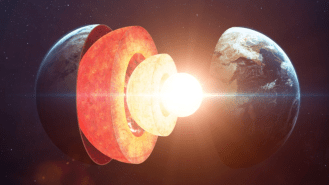Our units of time are not as constant as we think they are. The length of a day depends on how long it takes the Earth to spin on its axis. But all sorts of other things affect how long it takes our planet to do that. Gravitational interactions with other planets, activity in the oceans and the atmosphere, and the exchange of angular momentum between the Earth’s core and its mantle, all have a slight effect on how long it takes the Earth to complete its rotation.
What scientists did not expect to find was that the length of a day oscillates back and forth. In 2013, scientists discovered a six-year cycle in the length of the day, increasing and decreasing by just over 0.1 milliseconds.
A fraction of a millisecond may not seem like much, but it left scientists scratching their heads.
Recently, Wei Wang and John Vidale from the University of Southern California unearthed a clue about why this might occur when they looked at old seismic data from underground Soviet nuclear tests. The data revealed strange goings-on in the Earth’s inner core — events that just might explain why the length of a day changes. Their results were recently published in Science Advances.
Explosive research
In the 1940s, nuclear weapons were tested above-ground. Happily, it only took people a few years to figure out that this was a really bad idea. Radiation and fallout from these tests was widespread, even traveling all the way to New York from Nevada. By the early 1960s, most countries had decided to do their testing underground, where nuclear radiation could be contained.
In order to detect and monitor these tests, several seismic arrays were built around the globe. A seismic array is a set of seismographs laid out in a pattern to give them increased sensitivity both to earthquakes and to underground nuclear tests.
Among these was the Large Aperture Seismic Array, or LASA, located in Montana. LASA operated from 1964 until 1978, by which time underground nuclear testing had decreased.
Decades later, Wang and Vidale found some unexpected patterns in the data LASA provided.
A surprise in the data
The data from LASA is unique — modern seismic data gleaned from earthquakes comes nowhere close to the matching LASA’s sensitivity. In fact, for the 14 years that LASA was running, scientists were able to measure more than just earthquakes and nuclear tests — they were able to pick up data about what was going on in the middle of the earth.
The inner core of the Earth is about the size of Pluto. It is a solid ball of mostly iron and nickel. It is challenging, if not impossible, to observe it directly. To understand what the core of the Earth is doing, scientists rely on seismic waves. These change speed and direction as they travel through the planet.
Seismic data from nuclear weapons tests are far more telling than earthquake data alone. “Very powerful and very quick nuclear explosions are uniquely suited to look for small differences in the particular waves we are watching,” Vidale explained to Big Think. “The LASA set of seismometers that we used was turned off in the 1970s, and will probably never be matched.”
Earthquakes and nuclear explosions emit a variety of wave types. One of these types is P waves. Also called primary waves, they act a lot like sound waves, compressing and expanding the material they move through. As P waves reach the Earth’s inner core, they can backscatter.
Wang and Vidale were able to measure how the P waves from Soviet nuclear tests backscattered from the inner core. They measured the arrival times of backscattered waves from the core for events that occurred between the years 1969 and 1974. The expected arrival time of the waves changes depending on the speed and direction of rotation of the core. The data showed that the rotation of the inner core did in fact seem to change. Not only that — the direction of the rotation actually reversed.
To understand how the researchers could infer that the core’s rotation had changed direction, imagine a dolphin using echolocation to spot a fish. It sends out a series of sound waves that bounce off objects in its environment. If a fish is moving toward the dolphin, the sound waves will return to the dolphin in quicker succession than if the fish is moving away. In a similar fashion, P waves traveling within the Earth return faster if the core is rotating toward the observer than away.
The inner core may be the key to the length of a day
The discovery was a total surprise. “We expected to see fairly steady rotation, maybe changing slowly over decades, not a reversal of motion,” Vidale said. Previously, scientists believed that the Earth’s inner core rotated slightly faster than the crust.
“The oscillation [we see] resembles a pendulum,” Vidale explained. “It goes one way for a while, then reverses, repeating the cycle for many iterations. There is a preferred position for the inner core, a gravitational well, and it oscillates about that position.”
This oscillation has a period of about six years. And it may explain why the length of the day changes slightly over this time period.
In order to understand this reversal of rotation, the authors posit a simple model that includes the gravitational interaction between the mantle and the core, as well as the topographies where the core meets the mantle, and where the inner core meets the outer core. If the inner core rotates at a different speed than the mantle and crust, there is an exchange of angular momentum between the two. The “differential rotation angle,” as it is called, corresponds to the change in length of day.
While it is not the only possible explanation, the researchers propose that the reversal of direction does indeed help to explain the changes in time. It may well be that the explanation of this scientific mystery was under our noses all along.
This article was reprinted with permission of Big Think, where it was originally published.






